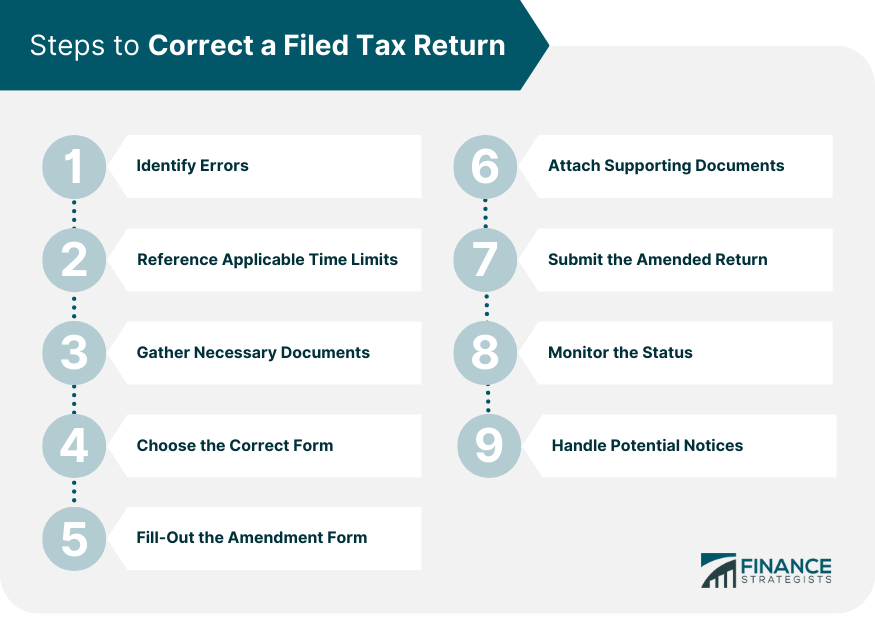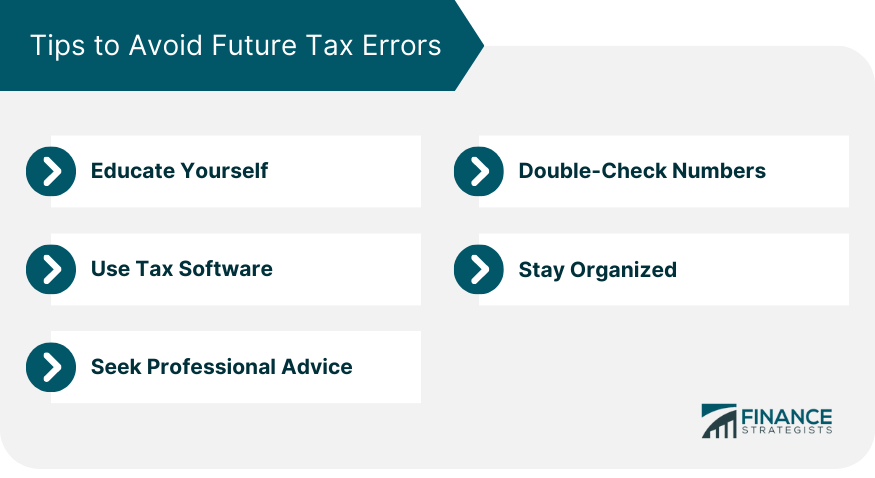A tax return is an official document that taxpayers submit to the relevant governmental authority, reporting their financial earnings, expenses, and other pertinent details over a specific period. This form allows the government to calculate and ensure that the taxpayer has paid the correct amount of taxes. Every year, individuals and businesses are required to file their tax returns, ensuring that they have contributed their fair share to the state's or nation's revenue. By filing, many discover that they have overpaid during the year and are therefore entitled to a refund. Nevertheless, accuracy in this documentation is paramount. Any discrepancies or errors can lead to complications, audits, or penalties, making it essential for taxpayers to approach the process with care and thoroughness. Take a thorough look at the tax return you've previously submitted. Double-check all the numbers and details. Some frequent slip-ups to keep an eye out for include: Math Mistakes: Simple calculation errors, like incorrect additions or subtractions, can lead to bigger problems. It's crucial to ensure that the totals match up with your working figures. Income Reporting: Ensure you've listed all your sources of income. Cross-check your return with your W-2s, which display your wages, and 1099s, which show other types of income like freelance work, interest, or dividends. Filing Status Confusion: Make sure you've chosen the right status. Did you mark 'single' when you're married or vice versa? This can affect the tax rate and certain deductions. Missed Deductions: Look over the entire year and make sure you've included eligible deductions like student loan interest, charitable donations, or home office expenses. Credit Issues: Ensure you've claimed the right credits and that you're eligible for them. Both the IRS and most state tax departments have specific windows during which you can submit corrections: Usually, you get a three-year window starting from the day you first filed your tax return. But if you made a payment, a different rule applies: you have two years from the day you paid your taxes. Out of these two time frames, you need to use the one that gives you the most time. This period is your deadline to use the Form 1040-X if you think you're owed a refund. Rules can vary, so it's a smart move to check with your state's tax agency about their time limits for amending returns. Before diving into the correction process, it's a smart move to get all your paperwork in order. Income Documents: If you've got any new or additional W-2s (which show your salary) or 1099s (used for other types of income like freelance earnings, bank interest, or dividends) that came in after you filed, you'll need those on hand. Receipts for Deductions: If you're adjusting any deductions, gather all related receipts. Updated Forms for Credits: If you're updating or claiming new tax credits – like those for education, energy efficiency, or childcare – ensure you have the relevant documentation or forms to support those credits. Proof of Changes: This can be any document or evidence that justifies the corrections you're about to make. For instance, if you're correcting the amount of mortgage interest you paid, having a mortgage statement can be handy. For Federal Returns: Form 1040-X, also known as the "Amended U.S. Individual Income Tax Return" is the form you'll need. It's designed to let you highlight the changes you're making and explain why. For State Returns: Each state does things a bit differently. Head to your state's tax agency website or office. There, you can find out which form you'll need to fill out and any specific instructions on how to do it. When completing Form 1040-X or a state equivalent: Clearly specify the tax year you are amending at the top of the form. Provide a detailed explanation in the section provided about why you are making an amendment. Ensure that you recalculate the tax based on the new data and input the difference between the original and revised amounts. Any new or additional forms or schedules that have changed as a result of the amendment should be attached to the amended return. Making sure your paperwork matches your claims ensures the reviewing agent can quickly understand and approve your corrections. As of 2021, if you're updating your federal tax using Form 1040-X, you'll likely have to put it in an envelope and mail it to the IRS. However, some states are a bit more tech-savvy and might let you file amended returns online. Given how things can change, it's always smart to take a minute and check the latest scoop on the IRS website or with your local tax office. Once you've mailed off your amended return, make it a habit to periodically check where things stand. The IRS has a handy tool called "Where’s My Amended Return?" to help you keep tabs on your submission's status. By regularly checking in, you ensure you're informed of any developments and can act swiftly if further action is required on your part. Plus, it provides a sense of reassurance knowing that your paperwork is making its way through the system. If the IRS or your state tax office drops you a letter or notice, address any correspondence head-on and as soon as you can. Often, they might just need a bit more info or clarification. Responding promptly not only speeds up the amendment process but also shows the tax agencies that you're proactive and responsible about your finances. Educate Yourself: Tax laws and regulations can change. Dedicate some time each year to refresh your knowledge or attend a brief tax workshop. Staying informed helps you understand what's new and what's expected of you. Double-Check Numbers: After you've entered all your data, revisit each section to confirm that numbers, especially those related to income and deductions, are accurate. Use Tax Software: These programs often come with built-in error checks, prompts for deductions or credits you might be eligible for, and automatic calculations. They guide you step-by-step, reducing the chances of mistakes. Stay Organized: Regularly update a folder or digital storage space with relevant financial documents, so everything is at your fingertips when it's time to file. Seek Professional Advice: Consider consulting a tax services professional. Their expertise can guide you through complex situations and ensure your return is accurate. A tax return serves as a crucial instrument through which individuals and businesses convey their financial status to governmental authorities. This document ensures the accurate assessment of taxes owed by reporting earnings, expenses, and pertinent details over a specific period. The process of correcting a filed tax return involves identifying errors, referencing time limits, gathering documents, selecting forms, providing detailed explanations for changes, attaching supporting documents, and submitting the amended return. Monitoring the status of the correction and promptly addressing any notices from tax agencies is essential. To avoid future tax errors, individuals are encouraged to stay informed about changing tax laws, employ tax software, maintain organization of financial documents, and consider seeking professional advice when navigating complex situations. Adhering to these practices ensures a smooth and compliant tax filing experience.What Is a Tax Return?
Steps to Correct a Filed Tax Return
Identify Errors
Reference Applicable Time Limits
Internal Revenue Service
State Tax Departments
Gather Necessary Documents
Choose the Correct Form
Fill-Out the Amendment Form
Attach Supporting Documents
Submit the Amended Return
Monitor the Status
Handle Potential Notices

Tips to Avoid Future Tax Errors

Conclusion
How to Correct a Filed Tax Return FAQs
A tax return is an official document that taxpayers submit to the relevant governmental authority, reporting their financial earnings, expenses, and other pertinent details over a specific period.
Identify errors, gather documents, use the Form 1040-X for federal returns, provide explanations, attach support, and submit the amended return.
When filing a tax return, you should prepare documents such as W-2s (showing salary), 1099s (other types of income), receipts for deductions, updated forms for credits, and any proof of changes.
Yes, Form 1040-X is used for federal returns to highlight corrections and provide explanations for changes made.
Individuals should stay informed about changing tax laws and regulations, consider attending tax workshops, use tax software with built-in error checks, maintain organized financial documents, and seek professional advice when needed.
True Tamplin is a published author, public speaker, CEO of UpDigital, and founder of Finance Strategists.
True is a Certified Educator in Personal Finance (CEPF®), author of The Handy Financial Ratios Guide, a member of the Society for Advancing Business Editing and Writing, contributes to his financial education site, Finance Strategists, and has spoken to various financial communities such as the CFA Institute, as well as university students like his Alma mater, Biola University, where he received a bachelor of science in business and data analytics.
To learn more about True, visit his personal website or view his author profiles on Amazon, Nasdaq and Forbes.















